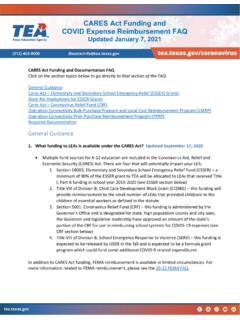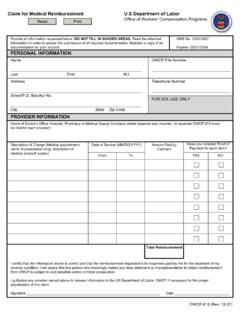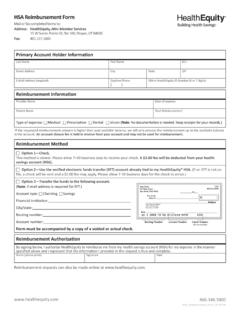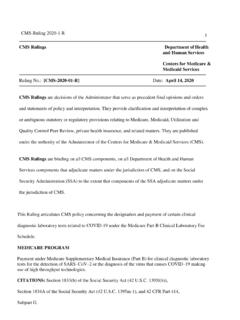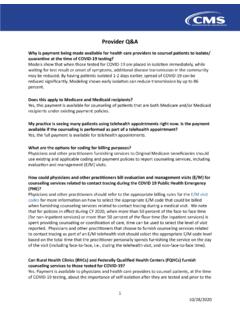Transcription of Telemedicine: Add Title Policy, Billing & Reimbursement
1 Add TitleTelemedicine: Policy, Billing & ReimbursementMichigan Medicaid Telemedicine: The Basics Telemedicine is the use of telecommunication technology to connect a patient with a health care professional in a different location. MDHHS requires a real time interactive system at both the originating and distant site, allowing instantaneous interaction between the patient and the health care professional via a telecommunication system. The technology must meet the needs of audio-visual compliance in accordance with current regulations and industry standards. Important: originating and distant site provider must ensure the privacy of the beneficiary as well as the security of any information shared via of Services allowed via telemedicine End Stage Renal Disease services (ESRD) -90951-90970 (16 services) Behavior change intervention (smoking cessation) -99406-99407 (2 services) Behavioral Health &/ or Substance Use Disorder -90785, 90791 90792, 90832 90840, 90846 90847, 99354 99355 (15 services) Education Services -97802-97804, 99497 -99498, G0420-G0421 (7 services)
2 Remote Retinal Imaging, Dx and Management -92227 and 92228 (2 services) Inpatient consultations 99251-99255, G0425-G0427, G0508-G0509 (10 services) Nursing facility subsequent care 99307-99310 (4 services) Office or other outpatient consultations 99241-99245 (5 services) Office or other outpatient services 96150 -96154, 96160 9661, 99201 -99205, 99211 -99215 (17 services) Psychiatric diagnostic procedures -96116, 99408-99409 (3 services) Subsequent hospital care 99231-99233, 99356 -99357, 99495 -99496, G0406 -G0408, G0459 (11 services) Training service (Diabetes Self-Management)-G0108-G0109 (2 services) Telehealth Site Facility Fee (only allowed at originating site)-Q3014 ( 1 service)Face to Face vs Telemedicine Certain services require a face to face component, for these services a telehealth service cannot be used as a substitute but can be used in addition.
3 These include: ESRD requires at least one hands-on visit to view the vascular site. Nursing facility services require that the initial visit be face-to-face. Some psychiatric services performed as an assessment are best done face-to-face and although there is not a specific regulation that governs this there is a reasonable standard that tells the provider that certain things must be observed in of Modifier(s)and Place of Service (POS) MDHHS requires that services performed via telemedicine utilize the GT modifier as well as using the POS where the patient is located at the originating site and for the distant site provider to use the POS where they are located.
4 Medicare uses a combination of modifier and POS. Remember when Billing you must use the primary payer s rules. POS 2 Used by distant site provider for Medicare-The location where health services and health related services are provided or received, through telecommunication system. Modifiers Utilizes several modifiers depending on the situation. (95 & GT) additional Modifiers Modifier 95 -Synchronous telemedicine service rendered via a real-time interactive audio and video telecommunications system Synchronous telemedicine service is defined as a real-time interaction between a physician or other qualified health care professional and a patient who is located at a distant site from the physician or other qualified health care professional.
5 The totality of the communication of information exchanged between the physician or other qualified health care professional and the patient during the synchronous telemedicine service must be of an amount and nature that would be sufficient to meet the key components and/or requirements of the same service when rendered via a face-to-face interaction. Modifier 95 may only be appended to the services listed in appendix P. appendix P is the list of CPT codes for services that are typically performed face-to-face but may be rendered via a real-time (synchronous) interactive audio and video telecommunications system.
6 CQ Telehealth store and forward although recognized as a valid modifier should not be used for Medicaid Reimbursement of telemedicine services. GT Interactive telecommunication -Best represents MDHHS current policy for Billing telemedicine Originating Sites:Where the beneficiary is located County mental health clinic or publicly funded mental health facility Federally Qualified Health Center (FQHC) Hospital (inpatient, outpatient, or critical access hospital) Office of a physician or other practitioner (including medical clinics) Hospital-based or CAH-based Renal Dialysis Centers (including satellites) Rural Health Clinic (RHC) Skilled Nursing Facility (SNF) Tribal Health Center (THC)What about home?
7 The current MDHHS telemedicine policy does not extend to POS outside those listed above. Why is that? When you think about the privacy and security requirements for the most part these who not be applicable to other locations. Use of Skype or other basic computer applications or people s I-Phones for instance are not secure and are easily compromised. There are several programs which are called telepractice to differentiate them from the telemedicine policy. Right now these are: School Based Services (SBS) Speech, language and hearing services Applied Behavior Analysis (ABA) 0368T, 0369T (observation and direction), 0370T (family behavior guidance) Assertive Community Treatment Program (ACT) H0039 (only tele psych allowed via telepractice Medication Therapy Management (MTM) 99605 -99607 Distant Site The distant site is the location of the physician or other practitioner providing the professional service.)
8 These providers are subject to the same laws, rules & regulations that would apply to any face-to-face service. For example: POS The provider should be utilizing the same POS as they would face-to-face. HCPCS Code The full requirements must be met in order to bill for any service. If the service requires an examination, then a facilitator can provide that hands on, but the distant site provider must apply their expertise in the exam in order to meet that requirement. Documentation All required documentation rules should be followed including identifying that the service was performed via Providers MDHHS uses a reasonable approach to the use of telemedicine.
9 If all of the answers to the questions below are yes then a physician or other qualified health professional (QHP) may provide the service using telemedicine. Is the physician or other QHP licensed under state law in Michigan? Is the physician or other QHP enrolled in CHAMPS? Is the physician or other QHP under contract with or authorized by an appropriate entity to provide the service? Is the service they are providing under their scope of practice? Is the physician or other QHP in the US or one of the recognized territories?Allowable Providers: additional Information Is the physician or other QHP licensed under state law in Michigan?
10 Circumstance--the professional is licensed but not in Michigan. Under Michigan law the provider must be licensed in the state where the beneficiary is located. Is the physician or other QHP enrolled in CHAMPS? In order to be reimbursed by MDHHS the provider must be enrolled, if they are not enrolled no payment can be made. Is the physician or other QHP under contract with or authorized by an appropriate entity to provide the service? Soon this part will go away as all providers will have to be enrolled. This has to do with credentialing and verification of licensure and making sure the provider is not under sanction.










